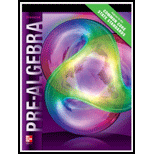
Concept explainers
(a)
To calculate: To find the probability of skateboarding being someone’s favorite sport
(a)
Answer to Problem 21PPS
The probability of skateboarding being someone’s favorite sport is
Explanation of Solution
Given information: Graph showing the results of class survey about student’s favorite X Games sport
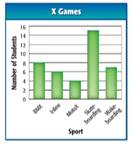
Formula Used:
Probability is defined as the likelihood of an event.
Probability is calculated as
Calculation:
Graph is given as follows:
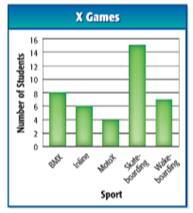
From the given graph,
Total number of students that are surveyed is calculated as follows:
Also, number of students having favorite Games sport as Skateboarding
Now, probability of skateboarding being someone’s favorite sport is calculated as
Conclusion:
Hence, required probability is
(b)
To calculate: To find how many students will choose inline as their favorite sport
(b)
Answer to Problem 21PPS
Explanation of Solution
Given information: Graph showing the results of class survey about student’s favorite X Games sport

Formula Used:
Probability is defined as the likelihood of an event.
Probability is calculated as
Calculation:
Graph is given as follows:
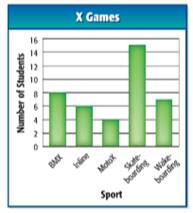
From the given graph,
Total number of students that are surveyed is calculated as follows:
Also, number of students having favorite Games sport as Inline skating
Now, probability of inline skating being someone’s favorite sport is calculated as
Now, suppose number of students is
Thus, number of students who will choose inline as their favorite sport is calculated as follows:
Conclusion:
Hence,
(c)
To calculate: To find how many more students will prefer BMX than MotoX
(c)
Answer to Problem 21PPS
Explanation of Solution
Given information: Graph showing the results of class survey about student’s favorite X Games sport
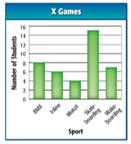
Formula Used:
Probability is defined as the likelihood of an event.
Probability is calculated as
Calculation:
Graph is given as follows:
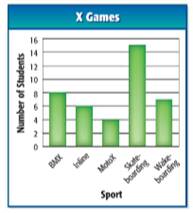
From the given graph,
Total number of students that are surveyed is calculated as follows:
Also, number of students having favorite Games sport as Inline skating
Now, probability of BMX being someone’s favorite sport is calculated as
Now, suppose number of students is
Thus, number of students who will choose BMX as their favorite sport is calculated as follows:
Similarly, number of students having favorite Games sport as MotoX
Now, probability of MotoX being someone’s favorite sport is calculated as
Now, suppose number of students is
Thus, number of students who will choose MotoX as their favorite sport is calculated as follows:
Hence, more number of students who will prefer BTX than MotoX is calculated as follows:
Conclusion:
Hence,
Chapter 13 Solutions
Pre-Algebra Student Edition
Additional Math Textbook Solutions
A First Course in Probability (10th Edition)
College Algebra with Modeling & Visualization (5th Edition)
Elementary Statistics (13th Edition)
Introductory Statistics
Basic Business Statistics, Student Value Edition
Elementary Statistics: Picturing the World (7th Edition)
- Solve the following system of equations: 50x+20y=1800 10x+3y=300arrow_forward> > > we are hiring Salesforce Admin Location: Remote Key Responsibilities: Administer Salesforce Sales & Revenue Cloud (CPQ & Billing) Configure workflows, validation rules & dashboards Automate processes using Flows & Process Builder Collaborate with Sales, Finance & Marketing teams Manage user roles & security Apply: Hr@forcecraver.comarrow_forwardAnswer this questionarrow_forward
- 1. vector projection. Assume, ER1001 and you know the following: ||||=4, 7=-0.5.7. For each of the following, explicitly compute the value. འབ (a) (b) (c) (d) answer. Explicitly compute ||y7||. Explain your answer. Explicitly compute the cosine similarity of and y. Explain your Explicitly compute (x, y). Explain your answer. Find the projection of onto y and the projection of onto .arrow_forward2. Answer the following questions using vectors u and v. --0-0-0 = find the the cosine similarity and the angle between u and v. འརྒྱ (a) (b) find the scalar projection of u onto v. (c) find the projection of u onto v. (d) (e) (f) find the scalar projection of onto u. find the projection of u onto u. find the projection of u onto and the projection of onto . (Hint: find the inner product and verify the orthogonality)arrow_forwardPlease type out answerarrow_forward
- The function f(x) = log x is transformed to produce g(x) = log (x) – 3. Identify the type of transformation and describe the change. Please type out answerarrow_forwardEach graph below is the graph of a system of three linear equations in three unknowns of the form Ax = b. Determine whether each system has a solution and, if it does, the number of free variables. A. O free variables ✓ B. no solution C. no solution D. no solution E. 1 free variable F. 1 free variablearrow_forwardSolve the following systems of equations and show all work.y = x2 + 3y = x + 5 Please type out answerarrow_forward
 Algebra and Trigonometry (6th Edition)AlgebraISBN:9780134463216Author:Robert F. BlitzerPublisher:PEARSON
Algebra and Trigonometry (6th Edition)AlgebraISBN:9780134463216Author:Robert F. BlitzerPublisher:PEARSON Contemporary Abstract AlgebraAlgebraISBN:9781305657960Author:Joseph GallianPublisher:Cengage Learning
Contemporary Abstract AlgebraAlgebraISBN:9781305657960Author:Joseph GallianPublisher:Cengage Learning Linear Algebra: A Modern IntroductionAlgebraISBN:9781285463247Author:David PoolePublisher:Cengage Learning
Linear Algebra: A Modern IntroductionAlgebraISBN:9781285463247Author:David PoolePublisher:Cengage Learning Algebra And Trigonometry (11th Edition)AlgebraISBN:9780135163078Author:Michael SullivanPublisher:PEARSON
Algebra And Trigonometry (11th Edition)AlgebraISBN:9780135163078Author:Michael SullivanPublisher:PEARSON Introduction to Linear Algebra, Fifth EditionAlgebraISBN:9780980232776Author:Gilbert StrangPublisher:Wellesley-Cambridge Press
Introduction to Linear Algebra, Fifth EditionAlgebraISBN:9780980232776Author:Gilbert StrangPublisher:Wellesley-Cambridge Press College Algebra (Collegiate Math)AlgebraISBN:9780077836344Author:Julie Miller, Donna GerkenPublisher:McGraw-Hill Education
College Algebra (Collegiate Math)AlgebraISBN:9780077836344Author:Julie Miller, Donna GerkenPublisher:McGraw-Hill Education





